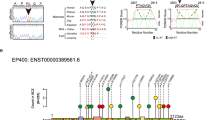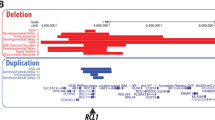Abstract
Schizophrenia is a common and etiologically heterogeneous disorder. Although inheritance of schizophrenic syndromes is complex with genetic and environmental factors contributing to the clinical phenotype, periodic catatonia, a familial subtype of catatonic schizophrenia, appears to be transmitted in an autosomal dominant manner. We report here that a Leu309Met mutation in WKL1, a positional candidate gene on chromosome 22q13.33 encoding a putative non-selective cation channel expressed exclusively in brain, co-segregates with periodic catatonia in an extended pedigree. Structural analyses revealed that this missense mutation results in conformational changes of the mutant protein. Our results not only underscore the importance of genetic mechanisms in the etiology of schizophrenic syndromes, but also provide a better understanding of the pathogenesis and incapacitating course of catatonic schizophrenia and related disorders.
This is a preview of subscription content, access via your institution
Access options
Subscribe to this journal
Receive 12 print issues and online access
$259.00 per year
only $21.58 per issue
Buy this article
- Purchase on Springer Link
- Instant access to full article PDF
Prices may be subject to local taxes which are calculated during checkout




Similar content being viewed by others
References
Leonhard K . Zur Unterteilung und Erbbiologie der Schizophrenien. 2. Mitteilung: Kombiniert-systematische und periodische Katatonien Allg Z Psychiat 1942 121: 1–35
Lesch KP, Stober G, Balling U, Franzek E, Margolis R, Ross C et al. Triplet repeats in clinical subtypes of schizophrenia: variation at the DRPLA (B37 CAG repeat) locus is not associated with periodic catatonia J Neural Transm 1994 98: 153–157
Stöber G, Franzek E, Lesch KP, Beckmann H . Periodic catatonia: a schizophrenic subtype with major gene effect and anticipation Eur Arch Psychiat Clin Neurosci 1995 245: 135–141
Stöber G, Saar K, Rüschendorf F, Meyer J, Nürnberg G, Franzek E et al. Splitting schizophrenia: periodic catatonia is an autosomal dominant disorder with a gene on chromosome 15q15 Am J Hum Genet 2000 67: 1201–1207
Nomura N, Miyajima N, Sazuka T, Tanaka A, Kawarabayashi Y, Sato S et al. Prediction of the coding sequences of unidentified human genes. I. The coding sequences of 40 new genes (KIAA0001–KIAA0040) deduced by analysis of randomly sampled cDNA clones from human immature myloid cell line KG-1 DNA Res 1994 1: 27–35
Caterall WA . Structure and function of voltage-sensitive ion channels Science 1989 242: 50–61
Ramashwami M, Gautam M, Kamb AA, Rudy B, Tanouye MA, Mathew MK . Human potassium channel genes: molecular cloning and functional expression Mol Cell Neurosci 1990 1: 214–223
Albrecht B, Weber K, Pongs O . Characterization of a voltage-activated K-channel gene cluster on human chromosome 12p13 Recept Channels 1995 3: 213–220
Coyle JT . Oxidative stress, glutamate, and neurodegenerative disorders Science 1993 262: 689–695
Lehmann-Horn F, Jurkat-Rott K . Voltage-gated ionchannels and hereditary disease Physiol Rev 1999 79: 1317–1372
Browne D . Episodic ataxia/myokymia is associated with point mutations in the human potassium gene KCNA1 Nat Genet 1994 8: 136–140
Browne DL . Identification of two new KCNA1 mutations in episodic ataxia/myokymia families Hum Mol Genet 1995 4: 1671–1672
Scheffer H . Three novel KCNA1 mutations in episodic ataxia type I families Hum Genet 1998 102: 464–466
Biervert C, Schroeder BC, Kubisch C, Berkovic SF, Propping P, Jentsch TJ et al. A potassium channel mutation in neonatal human epilepsy Science 1998 279: 403–406
Lieberman JA . Pathophysiologic mechanisms in the pathogenesis and clinical course of schizophrenia J Clin Psychiatry 1999 60: 9–12
Ciorba MA . Modulation of potassium channel function by methionine oxidation and reduction Proc Natl Acad Sci USA 1997 94: 9932–9937
Chen J . Acceleration of P/C-type inactivation in voltage-gated K+ channels by methionine oxidation Biophys J 2000 78: 174–187
Olney JW . Excitatory amino acids and neuropsychiatric disorders Biol Psychiatry 1989 26: 505–525
Gerlach M . New horizons in molecular mechanisms underlying Parkinson's disease and in our understanding of the neuroprotective effects of selegiline J Neural Transm 1996 48: 7–21
Acknowledgements
The authors would like to express their gratitude to the study participants and their family. They also thank P Riederer for sharing human brain samples, M Schartl and S Scherer for their help with the protein analysis, and C Müller-Reible for helpful discussions.
Author information
Authors and Affiliations
Corresponding authors
Rights and permissions
About this article
Cite this article
Meyer, J., Huberth, A., Ortega, G. et al. A missense mutation in a novel gene encoding a putative cation channel is associated with catatonic schizophrenia in a large pedigree. Mol Psychiatry 6, 302–306 (2001). https://doi.org/10.1038/sj.mp.4000869
Received:
Accepted:
Published:
Issue Date:
DOI: https://doi.org/10.1038/sj.mp.4000869
Keywords
This article is cited by
-
Plasma membrane localization of MLC1 regulates cellular morphology and motility
Molecular Brain (2019)
-
Subtyping schizophrenia: implications for genetic research
Molecular Psychiatry (2006)
-
Evidence implicating BRD1 with brain development and susceptibility to both schizophrenia and bipolar affective disorder
Molecular Psychiatry (2006)
-
Transmission disequilibrium test provides evidence of association between promoter polymorphisms in 22q11 gene DGCR14 and schizophrenia
Journal of Neural Transmission (2006)
-
Systematic mutation analysis of KIAA0767 and KIAA1646 in chromosome 22q-linked periodic catatonia
BMC Psychiatry (2005)



